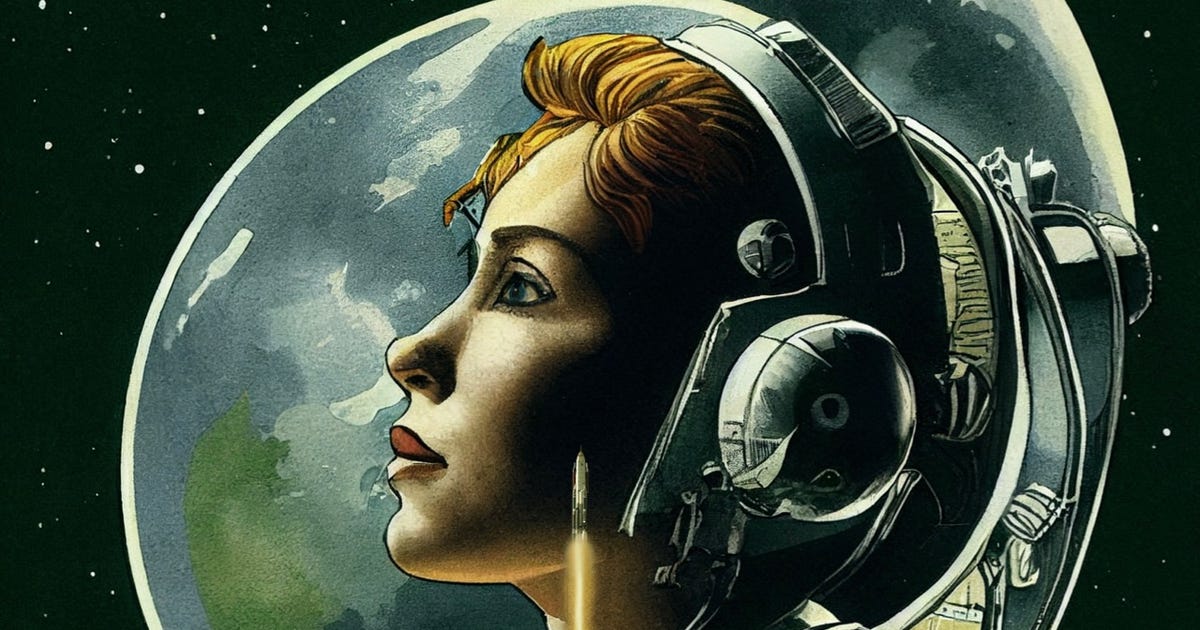
You might expect a comic book series featuring art generated by artificial intelligence technology to be full of surreal images that have you tilting your head trying to grasp what kind of sense-shifting madness you’re looking at.
Not so with the images in The Bestiary Chronicles, a free, three-part comics series from Campfire Entertainment, a New York-based production house focused on creative storytelling.
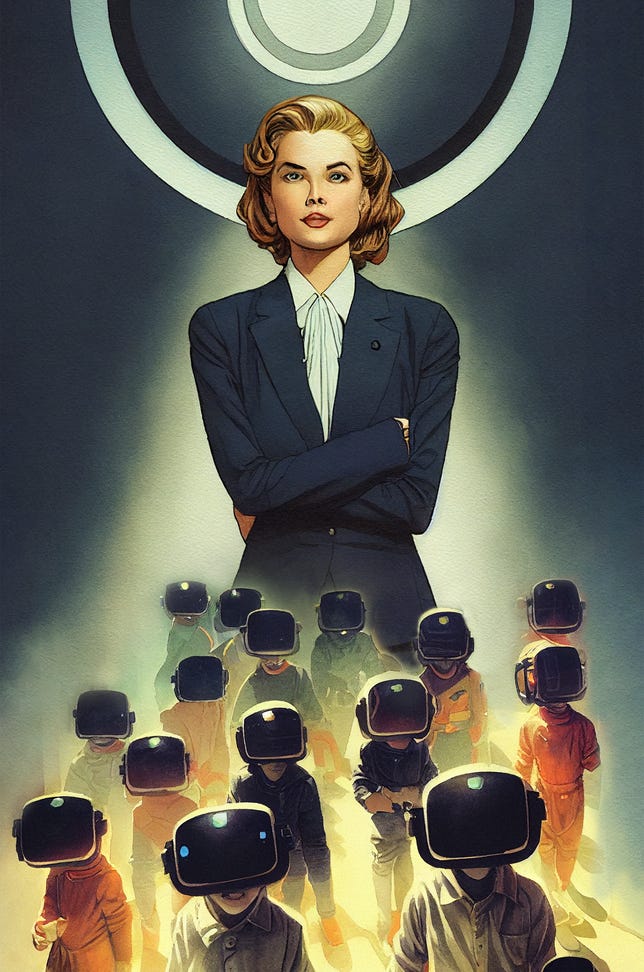
In The Lesson, a teacher tells students about the monsters that ruined their planet. The team behind the comic used the phrase “Hitchcock Blonde” to describe the story’s heroine to AI art-generation tool Midjourney, “and more often than not she came out looking like Grace Kelly,” says writer Steve Coulson.
Campfire, Midjourney
The visuals in the trilogy — believed to be the first comics series made with AI-assisted art — are stunning. They’re also stunningly precise, as if they’ve come straight from the hand of a seasoned digital artist with a very specific story and style in mind.
“Deep underground, the last remnants of humanity gather to learn about the monsters that have destroyed their planet,” reads a description of The Lesson, the visually rich retro-futuristic third comic in the trilogy. All three are available for download now on Campfire’s site, and also come in softcover and hardcover printed anthologies.
Though AI-generated visual art can tend toward the wildly absurd, the photorealistic humans in The Bestiary Chronicles don’t have rearranged facial features, or limbs protruding at odd angles. The monsters — with their glowing eyes and astonishingly bad teeth — look like love children of Godzilla and Vhagar and could hardly be mistaken for anything other than rage-filled beasts.
This algorithm-assisted art looks tailor-made for the dark dystopian tale, which leans on tropes from 1960 sci-fi horror film Village of the Damned and from THX 1138, George Lucas’ 1971 debut feature film.
“We’re seeing the rise of a completely new visualization tool that will radically change the storytelling process across both the comics industry and entertainment in general,” said Steve Coulson, writer of the trilogy and creative director of the award-winning Campfire, which has created immersive fan experiences for shows including Ted Lasso, Westworld and Watchmen. Its founders thought up The Blair Witch Project.
For The Bestiary Chronicles, Coulson turned to Midjourney, a service that quickly turns short text phrases, or “prompts,” into images by scanning a giant database trained on visual art by humans. Artificial intelligence tools like it, Dall-E and Stable Diffusion are capturing the internet’s imagination as they let anyone manifest images from text in intriguing and sometimes disturbing ways.
The Bestiary Chronicles is a 114-page science fiction odyssey about monsters born from man’s technological hubris. But it also showcases the remarkable progress of products like Midjourney, which are producing increasingly more sophisticated and refined images.
“By the new year, even the trained eye probably won’t be able to perceive an AI generation from any other,” Coulson said. “It’s exciting and terrifying at the same time. But you can’t put the genie back in the bottle, so we’re embracing the future as fast as we can.”
AI image generation is advancing so rapidly, he adds, that The Lesson, out Nov. 1, marks a clear visual step up from the first comic in the trilogy, Summer Island, a folk-horror story in the spirit of Midsommar that came out in August. During those three months, Midjourney went through two upgrades.
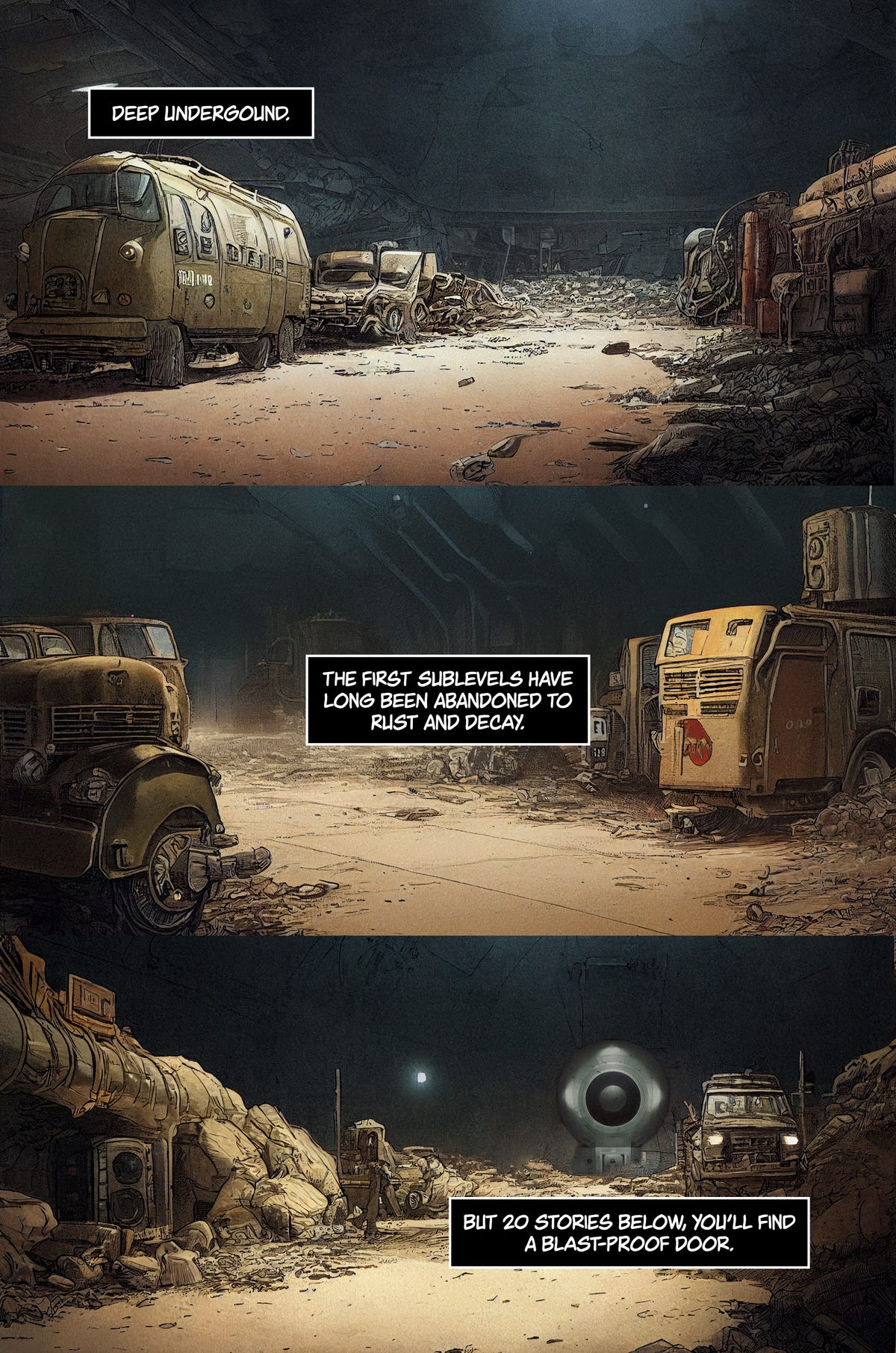
AI art-generation tool Midjourney did an impressive job coughing up images of a bleak postapocalyptic landscape for The Lesson, the third in a trilogy of comics from production house Campfire.
Campfire, Midjourney
AI, partner in art
“Technology is changing our world, with artificial intelligence both a new frontier of possibility but also a development fraught with anxiety,” Thomas P. Campbell, director and CEO of the Fine Arts Museums of San Francisco, said when the exhibit Uncanny Valley: Being Human in the Age of AI opened in 2020 to explore the ever-expanding space where humans and artificial intelligence meet.
AI generating visual art, composing songs and even writing poetry and movie scripts is driving some of that anxiety, raising ethical and copyright concerns among artists and even lawyers. AI art isn’t created in a vacuum. It works by absorbing and reconstructing existing art created by humans. As machine-made art improves, will those humans — actual graphic designers, illustrators, composers and photographers — find themselves edged out of work?
When an AI-generated picture won an art prize in September, some artists weren’t happy about it. “We’re watching the death of artistry unfold right before our eyes,” one Twitter user wrote.
Coulson, an avid comics reader since age 5, is among those pondering the complex questions raised by AI art, but he doesn’t think tools like Midjourney will replace the comics artists he’s long loved. “Those geniuses have an eye for dramatic composition and dynamic narrative that I strongly doubt machine learning will be able to match,” he writes in the afterword to Summer Island. “But as a visualization tool for nonartists like myself, it’s a hell of a lot of fun.”
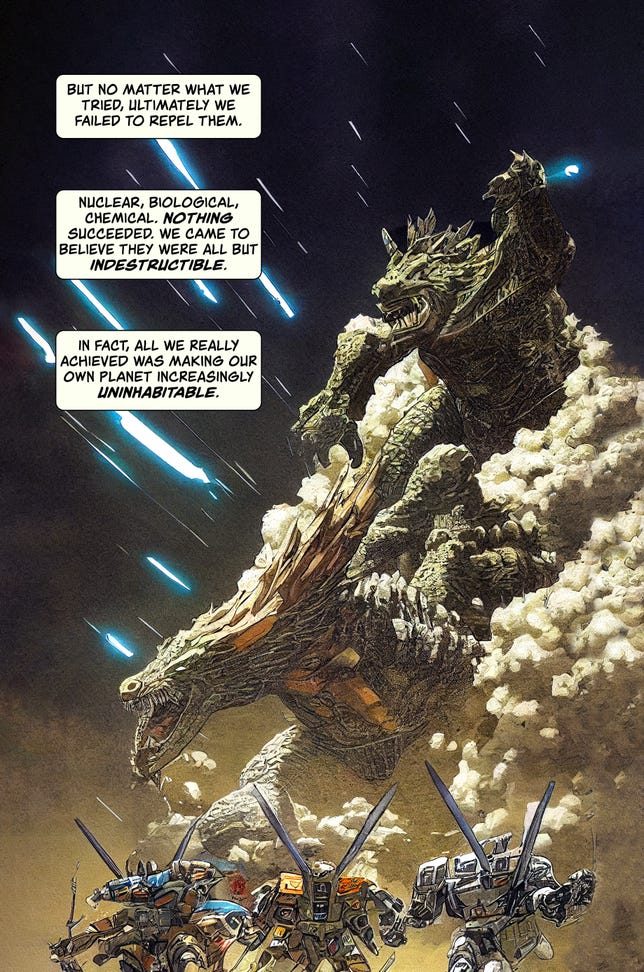
Has Midjourney been watching House of the Dragon?
Campfire, Midjourney
He does, however, see Midjourney as his true collaborator in The Bestiary Chronicles, even giving it an author credit. Where a comics artist might conceive of a narrative and then create art to illustrate it, AI-assisted images have the potential to more actively steer the story, or even change its direction, thus dramatically redefining the whole creative workflow. Coulson likens this human-machine duet to improv jazz.
“I would never ask a human artist to just ‘draw 100 splash pages and maybe I’ll pick the one I like the best,’ but Midjourney will happily spit them out 24/7,” Coulson says. “Then after we review the imagery, we start to assemble the story, almost as an act of collage, filling in gaps along the way.”
AI art is the star here, but humans had the decisive hand in which images made it into the final version of each story. They experimented with text prompts and carefully selected their final images from multiple Midjourney offerings, making a Photoshop tweak here and there, but mostly letting the machine-made work stand.
The Campfire team, for example, liked the rich effect produced by the style prompt “olive-green and sepia and teal-blue tritone print on watercolor paper,” so they used that one often to give images a painterly effect. For The Lesson, the phrase “futuristic underground bunker in the style of J.C. Leyendecker” yielded the perfect retro-futuristic postapocalyptic hideaway.
“We also used the phrase ‘Hitchcock Blonde’ to describe our heroine, and more often than not she came out looking like Grace Kelly,” Coulson said. That’s a fully recognizable Grace Kelly, without misplaced ears or a dog snout.
“The advances in AI image generation over the last few months have been exponential and mind blowing,” Coulson said, “and this technology is only going to get better — faster than we can imagine.”
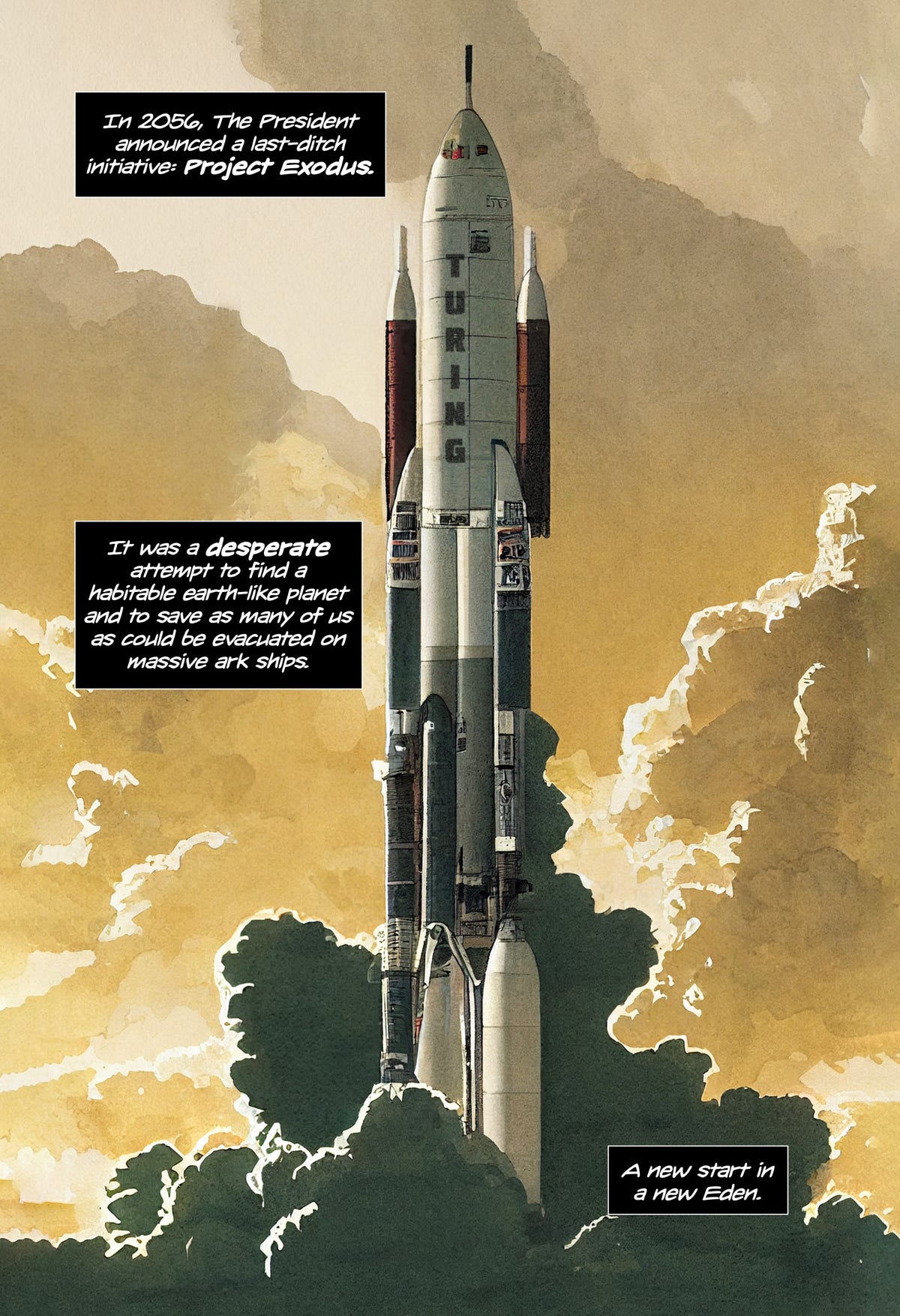
Exodus, the second comic in the trilogy, chronicles humanity’s last attempt to save itself from the monsters that roam the planet.
Campfire, Midjourney
